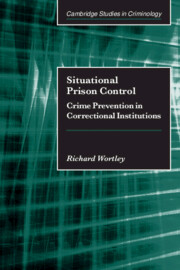Book contents
- Frontmatter
- Contents
- List of figures and tables
- Foreword
- Acknowledgements
- Part I Theoretical foundations
- 1 Introduction: why situational prison control?
- 2 Situational theories of prison behaviour
- 3 Situational methods of prison control
- 4 A model of situational prison control
- Part II Specific behaviours
- List of references
- Index
1 - Introduction: why situational prison control?
Published online by Cambridge University Press: 22 September 2009
- Frontmatter
- Contents
- List of figures and tables
- Foreword
- Acknowledgements
- Part I Theoretical foundations
- 1 Introduction: why situational prison control?
- 2 Situational theories of prison behaviour
- 3 Situational methods of prison control
- 4 A model of situational prison control
- Part II Specific behaviours
- List of references
- Index
Summary
This book examines the control of problem behaviour in prison from a situational prevention perspective. This examination of situational prison control is prompted by the accumulating evidence of success for situational prevention initiatives in reducing criminal behaviour in a wide range of community settings (Clarke, 1992, 1997; Poyner, 1993). The situational perspective on crime is a relatively recent criminal justice paradigm (Clarke, 1992, 1997; Cornish and Clarke, 1986) that shifts the attention from the supposed criminal disposition of the offender to the features of the potential crime scene that might encourage or permit criminal behaviour. Situational techniques involve the systematic manipulation of aspects of the immediate environments of potential offenders in an attempt to block or inhibit criminal responses. In this book it is argued that the same principles of situational management used in crime prevention may be usefully applied to the prison setting to help reduce incidents of assault, rape, self-injury, drug use, escape, collective disorder and so forth.
The situational approach depends upon a dynamic view of human action, one that stresses the fundamental variability of behaviour according to immediate circumstances. According to the situational perspective, behaviour can only be understood in terms of an interaction between the characteristics of an actor and the characteristics of the environment in which an act is performed. People behave the way they do because of who they are and where they are. The relationship between situations and behaviour can be examined from a variety of theoretical perspectives.
- Type
- Chapter
- Information
- Situational Prison ControlCrime Prevention in Correctional Institutions, pp. 3 - 14Publisher: Cambridge University PressPrint publication year: 2002



